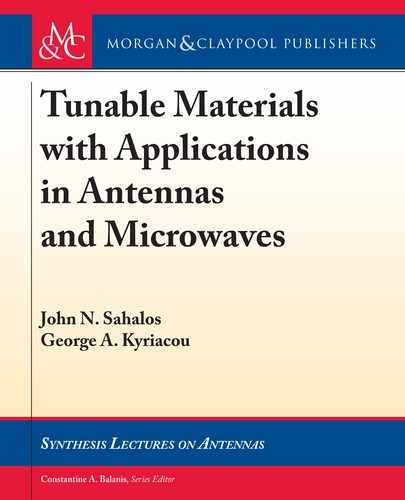
2.3. FERRIMAGNETICS: FERRITE MATERIALS AND MAGNETIC GARNETS 25
Table 2.1: Magnetic characteristics of materials
Magmetism Susceptibility Magnetic Properties
Material/
Susceptibility
Diamagnetism Negative and small
Zero magnetic
moments
Cu/-0.77×10exp(-6)
Au/-2.74×10exp(-6)
Paramagnetism Positive and small
Randomly oriented
magnetic moments
Pt/21.04×10exp(-6)
Mn/-66.10×10exp(-6)
Ferromagnetism Positive and large
Parallel aligned
magnetic moments
Fe/~100,000
Antiferromagnetism Positive and small
Mixed parallel and
antiparallel aligned
magnetic moments
Cr/3.60×10exp(-6)
Ferrimagnetism
Positive and large
function of applied
magnetic fi eld
Antiparrallel aligned
magnetic moments
Ba/~3
ferrite
2.3 FERRIMAGNETICS: FERRITE MATERIALS AND
MAGNETIC GARNETS
2.3.1 SPINNEL FERRITES
1. Chemical Composition
e first developed ferrites (around and after 1956) were ceramic-like, polycrystalline mag-
netic oxides with an iodestone-spinnel structure [5, 11]. eir generic chemical formula is
M
+2
Y
+3
2
O
–2
4
, where Y is usually trivalent iron (M
+2
Fe
+3
2
O
–2
4
). M is a divalent metallic ion
such as M
C2
D nickel (Ni), cobalt (Co), manganese (Mn), magnesium (Mg), cadmium (Cd),
chromium (Cr), or, in general, a metal of the transition series of the periodical table [12]. It is
also possible for M
C
2
to represent two types of ions, one of which is monovalent (e.g., lithium
Li
+1
) and the other trivalent (e.g., Fe
+3
) [13]. A useful spinnel ferrite is (Li
+1
Fe
+3
)
1/2
Fe
+3
2
O
–2
4
.
2. Crystal Structure
An example of a spinnel crystal structure [5, 13] is given in Figure 2.6. A point of interest is
that there are two types of lattice sites (A and B) within the spinnel crystal to be occupied by
the metallic ions (M
+2
or Fe
+3
). A sites, called tetrahedral, have four oxygen neighbors and B
sites, called octahedral, have six oxygen neighbors. Within each unit cell, there are 4 A sites,
16 B sites and 32 oxygen ions. e magnetic moments of ions, occupying A and B sites, are
aligned by exchange energy in such a way as to be anti-parallel. In this case, the net spontaneous

26 2. TUNABLE MATERIALS–CHARACTERISTICS AND CONSTITUTIVE PARAMETERS
(A
2+
)
IV
(B
3+
)
VI
O
4
2
Red (Oxygen), Blue (IV sites), White (VI sites)
Figure 2.6: e unit cell of a spinel crystal structure at various angles.
magnetization (M ) is the difference of the magnetization of the corresponding sub lattices M
A
and M
B
[5], namely, M D M
B
M
A
. is partial cancellation results in a lower net magneti-
zation and is called “ferrimagnetism.” In the case in which all magnetic moments are parallel,
the phenomenon of ferromagnetism occurs.
3. Controlling Saturation Magnetization
e saturation magnetization (M
S
) of spinnels may be controlled by the judicious choice of A
and B site ions. To increase M
S
, one could increase M
B
and decrease M
A
. is can be achieved
by a partial substitution of the M
C2
ion with a divalent nonmagnetic ion (e.g., Zn
+2
), which
has a strong preference for A site occupancy. For example, NiFe
2
O
4
and MnFe
2
O
4
become
Ni
X
Zn
1–X
Fe
2
O
4
and Mn
X
Zn
1–X
Fe
2
O
4
.
e above approach causes a reduction in Curie temperature T
C
because the alignment
of the magnetic moments at A and B sites is coupled through exchange of energy [5]. us, a
reduction in M
B
also results in a decrease in M
A
and, in turn, a decrease in M
S
as the temperature
increases. Recall that for temperatures equal or greater than the Curie temperature, the magnetic
moments’ alignment is destroyed, driving saturation magnetization to zero. Moreover, the partial
replacement of trivalent iron ions (Fe
+3
) with non-magnetic trivalent ions (e.g., Al
+3
), which
exhibit a strong preference for occupying B sites (e.g., NiAl
X
Fe
2–X
O
4
), results in a greater
reduction in
M
B
than in M
A
and, in turn, a reduction in M
S
accompanied by a decrease in T
C
.
To conclude this section, spinnel ferrites were the first to be invented and used in mi-
crowave applications. ese first developed ferrites were found to have unacceptably high ab-
sorption losses in the microwave range. However, these are now improved. e most com-
monly used spinnel ferrites are: nickel ferrite (NiFe
2
O
4
), lithium ferrite ((Li
+1
Fe
+3
)
1/2
Fe
2
O
4
),
and magnesium-manganese ferrite (Mn
X
Mg
Y
Fe
Z
O
4
), where x C y C z D 3 [12]. eir basic
characteristics, such as their saturation magnetization M
S
and Curie temperature T
C
, along with
a recommendation for their use, can be seen in Table 2.2. Complete data, including both mag-
netic and dielectric losses, can be found in the manufacturers’ data sheet, e.g., Trans-Tech [17].
..................Content has been hidden....................
You can't read the all page of ebook, please click here login for view all page.
